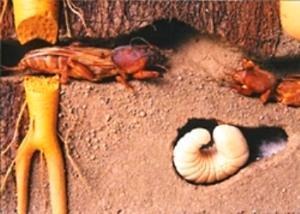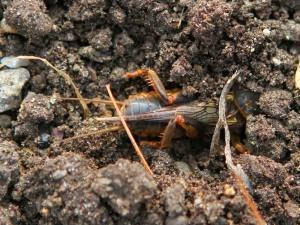Fighting the bear in the garden is one of the mandatory stages of growing healthy plants
 Many gardeners, having planted seedlings in the ground, relax at first. They think that the main job is done, now they just need to water and weed the beds on time. It would seem that the plants are already in the right permanent place, having moved from temporary pots to free space, but that was not the case. The next day, some of them are found to be damaged. Let's find out how to protect delicate immature plants from an uninvited guest - a bear.
Many gardeners, having planted seedlings in the ground, relax at first. They think that the main job is done, now they just need to water and weed the beds on time. It would seem that the plants are already in the right permanent place, having moved from temporary pots to free space, but that was not the case. The next day, some of them are found to be damaged. Let's find out how to protect delicate immature plants from an uninvited guest - a bear.
When is the fight against the bear in the garden carried out? Signs of the presence of an intruder
Medvedka is a very large insect of dark chestnut color with a shiny tint. Some pests are up to 6-7 cm in length. Thanks to its strong shell and highly developed forelimbs, it digs multiple burrows in the upper layers of the soil, which causes great harm, damaging plant roots and grown fruits. This becomes noticeable during the beginning of spring work, and especially after planting seedlings. It is very important to start the fight with the bear in the garden on time (at the end of April - May), before the mating season for this insect and the appearance of young individuals. You may find that the young plant has withered due to:
- bitten stem;
- damaged roots;
- the presence of multiple raised earthen grooves;
- holes in the ground near the stem, into which water quickly leaves when watering.
All of the above signals the presence of a bear on your site.
Basic methods for dealing with a bear in the garden
- Digging up the earth. Perhaps overwintered larvae will be accidentally discovered. The bear especially loves the admixture of organic fertilizers (manure, compost, etc.).
- The use of special tools. Among them, boric acid is very effective, which is scattered around the garden in many places.
- Protecting the roots of plant seedlings when planting. To do this, it is grown in disposable paper cups without a bottom. Thin walls (which then gradually dissolve and go into the soil) will be an excellent obstacle to fighting the bear in the garden. The bites of the pest will no longer be so dangerous to the hardened stems of plants.
In addition, there are many folk remedies, but they are not as effective as chemicals designed specifically to fight the bear in the garden.
It is important that the fight against the bear in the garden is carried out correctly and in a timely manner. Consider and apply useful tips, especially when starting spring work on the site and planting seedlings of young plants.

A bear in the garden is, indeed, a serious problem. It eats up the roots and the plant dries up. It also spoils potatoes, beets, carrots. I have been fighting a bear in my garden for many years with folk remedies. But, as written in the article, they are ineffective. I did not know about the use of boric acid, I will definitely try.I also want to give advice: the bear is a poisonous insect. Therefore, if you find a bear in yourself in the garden, be careful to avoid being bitten.